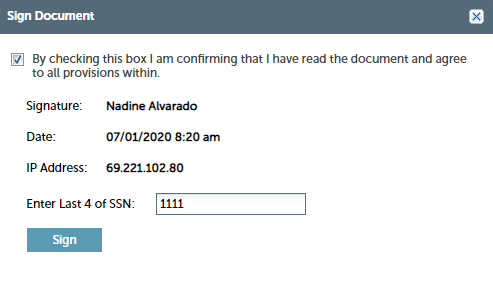5 Benefits of Businesses Using e-Signature
Cloud-based technology makes it much easier to handle processes like open enrollment, time tracking, and payroll processing. However, many companies still use a manual process to collect signed paperwork from employees. Having an employee physically sign a document is cumbersome and time-consuming.
In the age of the digital experience, the benefits of e-signature have never been greater. So let’s talk about what electronic signatures are and the advantages of using this process to streamline the employee experience. If you’re not already using electronic signatures for document signing, now’s the time to start.
What is the Significance of Electronic Signature?
An e-signature is intended to provide a secure and accurate identification method for the signer of a document. It is legally binding, as long as it adheres to the requirements of the specific regulation it was created under.
What is the Difference Between a Digital Signature and an Electronic Signature?
It’s important to note electronic signatures are different from digital signatures. An e-signature is an electronic symbol attached to a contract or other record and used by a person to sign. A digital signature is a technology that guarantees an electronic document is authentic.
How Can I Create AN Electronic Signature?
There are several applications available to electronically sign documents, depending on what devices your employees are using.
- Windows: Adobe Reader
- Mac: Preview
- iPhone and iPad: Mail or Adobe Fill & Sign
- Android: Adobe Fill & Sign
- Chromebook: HelloSign

Electronic Signature Example In Adobe Reader

Electronic Signature Example In Adobe Reader
Ready for E-Signature?

E-signature in self-service Mobile App
Are Electronic Signatures Safe?
Yes, e-signatures are safe because they come with an electronic record that serves as an audit trail and proof of transaction. Electronic signatures can also record the geolocation of where a document was signed. However, a handwritten signature can easily be forged or tampered.
5 Benefits of Businesses Using e-Signature
1. Easy To Use Across A Dispersed Workforce
Using e-signature for a remote workforce ensures important documents are signed in a timely manner. Employees don’t have to come into the office to sign paperwork. Employers don’t have to wait for signed documents to be returned. Signatures are instant, verified, and secure.
This saves valuable time for employees and HR managers who may be working from home. Businesses see an 80% average reduction in turnaround time using electronic signatures.
2. Paperless Workflows
Another benefit of electronic signing is the automation of paper-based processes. Businesses achieve 70%-80% efficiency improvements after removing manual processes to adopt digital technologies like e-signature. Your company can automate payroll and HR workflows such as:
- Time card approvals
- Performance reviews
- Receipt of property for remote employees
- Employee handbooks
- New hire paperwork
3. Centralized Document Storage
When paired with a cloud-based payroll and HR solution, you get the benefit of centralized document storage. Businesses save 86% in document costs using e-signatures. You’ll replace stacks of papers in file cabinets with digital documents stored in a safe, secure online database.
4. Better Employee Experience
Employees prefer self-service apps because they are convenient and provide instant access to data. With just a few taps, employees can electronically sign important documents and get back to work.
E-signature can also optimize your recruiting and onboarding processes. Employees can electronically sign new hire paperwork, and get started even sooner. When you give your staff tools that make their jobs easier, they are happier and more productive.
5. Cost Savings
All the benefits we’ve discussed so far add up to one big advantage: cost savings. The e-signature process saves companies on paper, printing, postage, mailing supplies, and shipping costs. These savings may not seem like much, but they add up over the years.
Time can also be used to measure cost savings. There’s time spent getting a physical document prepared, waiting days, or even weeks for your employee to sign it. Businesses that adopted an electronic signature process saved 22,000 hours annually. Think about what else you can get accomplished with that time back.
Signed, Sealed, and Delivered
In today’s digital workforce, paper documents and wet-ink signatures are antiquated. Businesses are more concerned with maintaining security, reducing their carbon footprint, and increasing productivity. One of the ways to accomplish these goals is by adopting an electronic signature process.
The benefits of e-signature far outweigh the reasons to continue using paper-based processes. Employees who work remotely are productive while e-signing documents in a timely manner. HR managers can spend their days on more strategic tasks like recruiting and training initiatives. E-signature is a tool all businesses benefit from, so what are you waiting for?



